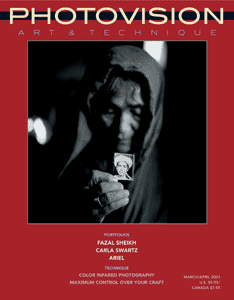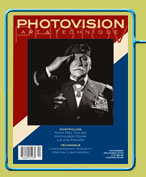From the Editor: VOL. 3, NO.4 • MARCH/APRIL 2003
 It’s been a long time since we received any reader’s mail on digital vs. photography. We thought things had quieted down. Then we received a letter from Norman Koren, which we published in the Jan/Feb 2003 issue, with a response from the editor. This sparked a spate of letters with the sole purpose of convincing me that digital and photography are exactly the same, only different. It’s been a long time since we received any reader’s mail on digital vs. photography. We thought things had quieted down. Then we received a letter from Norman Koren, which we published in the Jan/Feb 2003 issue, with a response from the editor. This sparked a spate of letters with the sole purpose of convincing me that digital and photography are exactly the same, only different.Perhaps I should clarify my position. I emphasize the “my” because it is not necessarily the position of all the members of our staff, in fact, I can almost hear Robert Hirsch rending his clothes and gnashing his teeth as he reads this. Therefore, what I have to say below is my own opinion, not that of Robert or anyone else, including the publisher. I have no issue with digital. I’ve said it often in the pages of this magazine and in other forums. I even encourage students to bring digital cameras on some workshops (darkroom workshops excepted). I have used a Minolta DiMAGE 7i for a paid commercial assignment, a Nikon D-100 for fun, and a Leica DigiLux on workshops. I recently took a digital lightroom workshop in Seattle with Scott Bourne, www.photoschool.info, a master at his craft. I am aware of how easy it is to spot prints and combine elements in the computer. I’m duly impressed. Does that mean I want to make digital imaging my primary medium of expression? Just because Photoshop® is a superior retouching tool, far easier and faster for most people to use than Spotone® or color dyes? Just because I can preview and erase unwanted images on the back of a digital camera, instead of waiting to process my film, does that mean I’m going to give up what I love—the art and craft of photography? The beauty of a silver print? The precious time I spend in a darkroom, watching a carefully crafted print appear in the developer? The excitement of spooling new negatives off a reel and seeing them for the first time? The skill it takes to properly expose a roll or sheet of film, and the pride in doing it? To me, it’s not about the end; it’s about the means. For me, Photovision is about silver-based processes, and those that may be tangentially related. Digital processes may record light, but so do electron microscopes. Some of the differences, though certainly not all, are that silver-based processes often use a darkroom instead of a computer monitor. Silver-based processes often require you to get your hands wet, instead of carpal tunnel syndrome and bad eyes. Silver-based processes usually result in prints that are made one at a time by the artist, not run off in batches of 100 by pushing the print key. There are more differences, but by and large you get the “picture.” Now to the real problem, and why I agreed to edit Photovision. All the pre-digital processes exist side-by-side, platinum, silver, gum dichromate, carbon, bromoil, etc. They have for over 160 years. For the first time in the history of photography a process has come along, digital imaging, that not only threatens to bury all other forms of photography, but is sworn to do so by the largest manufacturers of film and paper. Why? Is it because digital imaging is inherently better than photography? No. Is it because the manufacture of silicon chips is more environmentally friendly than using organic darkroom chemicals? No. The reasons are that digital cameras cost less to make (and can be sold for more money); film is not as profitable as silicon chips; film coating machines are expensive to build, maintain, and operate. And through the use of mass advertising campaigns the consumer can be convinced to buy cutting edge technology that is obsolete when they leave the store (see Robert Brummit’s letter in Reader’s Forum for the cost of digital). As long as I am the editor I will do my best to provide a forum for photographers who do not believe themselves to be obsolete. Photographers both established and emerging who continue to share a vision brought to fruition through pre-digital processes. A place where photographers can share techniques such as Lith Printing, infrared photography, sensitometry, etc., without someone trying to push the latest Photoshop® retouching techniques and convince them that the manufacture of millions of silicon chips is more environmentally friendly. It is my strongly held belief that all artists need a forum in which to show and share their work and techniques. This forum can manifest as galleries dedicated to their medium, magazines, salon gatherings, even heated discussions in coffee houses. But they must have a forum or their art will wither and die. I feel that Photovision is just such a forum for pre-digital photographers. In this issue we are featuring the work of award winning photographer, Fazal Sheikh. Fazal has worked extensively in refugee communities, trying to bring world understanding and compassion for their plight. We continue the photodocumentary theme in this issue with the work of Carla Swartz. I met Carla last year at the Review Santa Fe (along with Corrie McCluskey, January/February 2003) and was very impressed with her series on drag queens in Omaha. Our third portfolio literally came to us out of the blue. Mary Jo Fahey contacted us and asked if she could submit a piece on the work of Ariel. Ariel photographs sacred sites around the globe using black-and-white infrared film. What is so peculiar about Mary Jo’s timing is that we already had planned to run Steven H. Begleiter’s article on using color infrared film. Well, maybe that’s not so weird, but it doesn’t take much to get us excited around here. Steve Anchell Editor Email: pvedit@ctelco.net |
